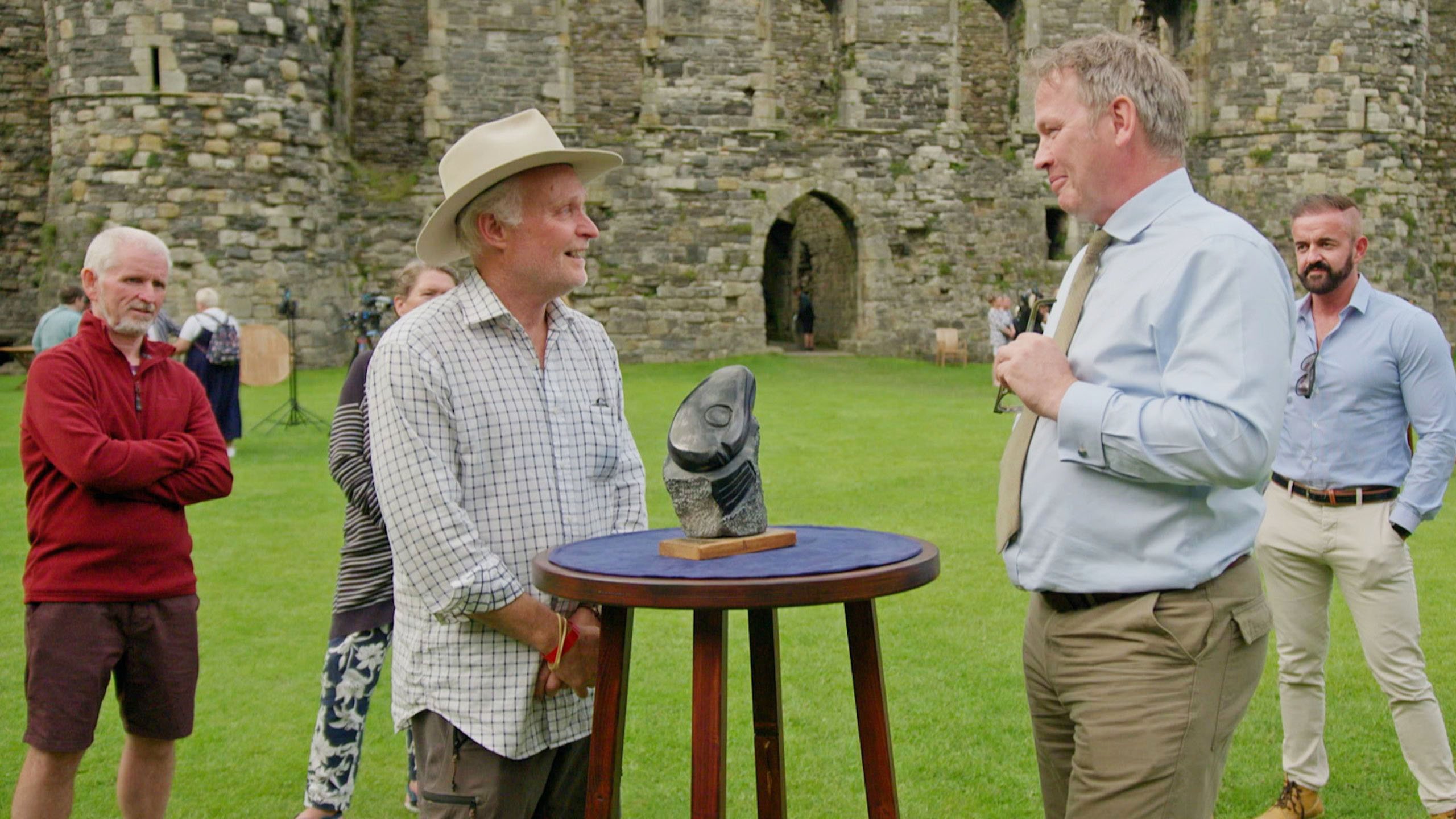
The first item evaluated during the most recent episode of Antiques Roadshow on the BBC was revealed to be a rare Ben Enwonwu sculpture. The work, estimated to be worth between £10,000 and £15,000 ($12,750–$19,000), had been used as a doorstop by the owner who purchased it for a fraction of that price at a sale.
The guest who brought in the small, dark stone sculpture told antiques expert John Foster: “I’ve always been perplexed by wondering what it is. It’s been a doorstop for the last 12 months.” He explained that he had “picked it up in a car boot sale in Anglesey about three years ago,” and “paid £50 [$63] for it.”
The abstract stone work was presented on a wooden base, which featured a small plaque reading “Ben Enwonwu–Igbo Sculpture” and underneath bore the signature of Zwemmer Gallery. Zwemmer Gallery in London, opened initially as an extension of a bookshop, first exhibited Enwonwu’s work in 1937. It was the presence of the Zwemmer mark that convinced Foster of the sculpture “being absolutely genuine.”
Antiques Roadshow presenter Fiona Bruce and expert Lisa Lloyd at Beaumaris Castle (Series 47). Image courtesy of BBC Studios.
Foster estimated, based on its style, that the carved stone sculpture dated to the 1970s, a decade during which Enwonwu, then in his mid-50s, was achieving great acclaim. In 1971, he became an Officer of the National Order of the Republic in Senegal, the visiting artist at the Institute of African Studies at Howard University, and the first professor of Fine Arts at the Nigerian University of Ife. In 1977, he worked in Lagos as an art consultant for the Second World Black and African Festival of Arts and Culture.
When the value was revealed to the guest, he appeared visually shocked, saying: “Really? I’ll have to speak Welsh. Bendigedig!” (“Bendigedig” means “wonderful” or “fantastic” in Welsh.) He admitted that he “could cry” and that “in an ideal world I’d love to keep it but, probably not. I have to be pragmatic…”
Monday’s episode—the ninth episode of the 47th series of the hugely popular series which has been running in the U.K. since 1979—was filmed in Beaumaris Castle in Anglesey, Wales’s largest island off the North-West coast. The owner of the sculpture said that he had come to Beaumaris “just on the off chance of having a nice day out. I thought it might be worth £100. I paid 50, so I thought if I could double my money, I’d be laughing.”
Ben Enwonwu, Tutu (1974). Courtesy of Bonhams London.
Enwonwu sculptures can sell for up to six figures. His bronze figurative sculpture Atlas sold for £378,000 ($521,595) at Sotheby’s London in 2021; and two of his paintings have sold for over £1,000,000 ($1,274,000) in recent years. Born Odinigwe Benedict Chukwukadibia Enwonwu in 1917, Onitsha, Nigeria, Enwonwu was described as a “pioneer” by Foster, who called him one of the first artists to combine Western and African influences in their work. In 1946, Enwonwu exhibited alongside Picasso in Paris, and 10 years later he was commissioned to create a sculpture of Queen Elizabeth II—the first African artist commissioned for such a project. A household name in Nigeria, his market expanded rapidly in recent years in Europe after his work was showcased at Frieze Masters by Lagos-based Kó Gallery in 2020.
Ben Enwonwu, Yams (1942). Image courtesy of The National Archives.
The Antiques Roadshow episode has aired the same week that another previously unknown work by Enwonwu was discovered, this time at The National Archives in London.
Yams, a print of a watercolor poster made by Enwonwu in 1942 depicting the transportation of yams along a river, was commissioned by the Ministry of Information as part of its efforts to increase food production in West Africa. The work was authenticated by Giles Peppiatt, the director of modern and contemporary African art at Bonhams. Neither Peppiatt nor Sylvester Okwunodu Ogbechie, Enwonwu’s biographer, were aware of the existence of Yams before its discovery by National Archives’ visual collections specialist Sarah Castagnetti in guard book INF 2/9.
Six years ago, another lost work by Enwonwu hit the headlines when it sold for £1.2 million ($1.53 million) at Bonhams London. The painting, Tutu (1974) was part of a three-portrait series depicting the Ife princess Adetutu Ademiluyi, which went missing in 1975. The Bonhams painting was rediscovered in a London flat in 2017 and far exceeded its high estimate of £300,000 ($382,000) during a 20-minute bidding war.